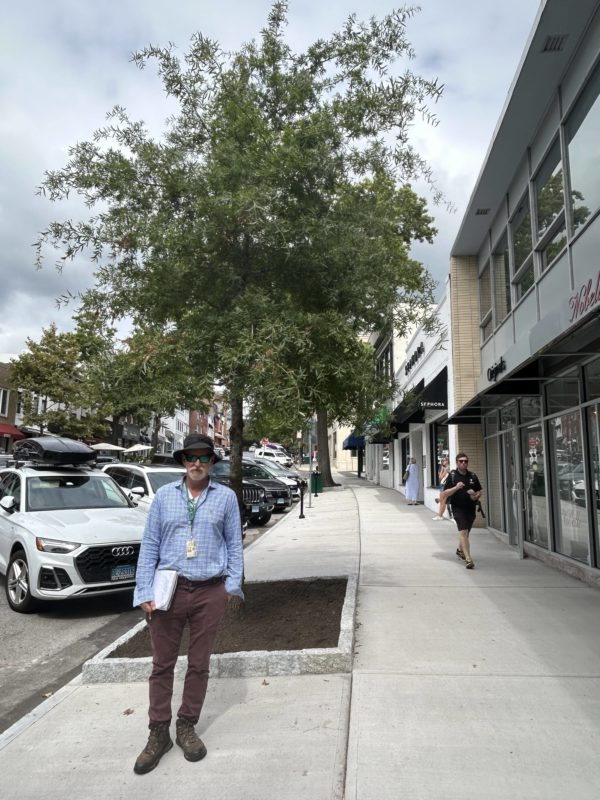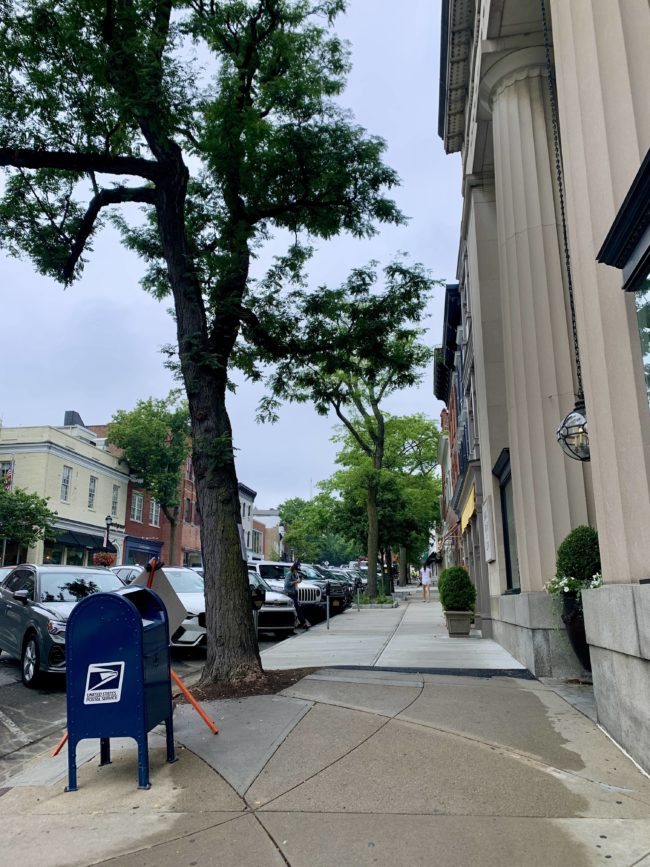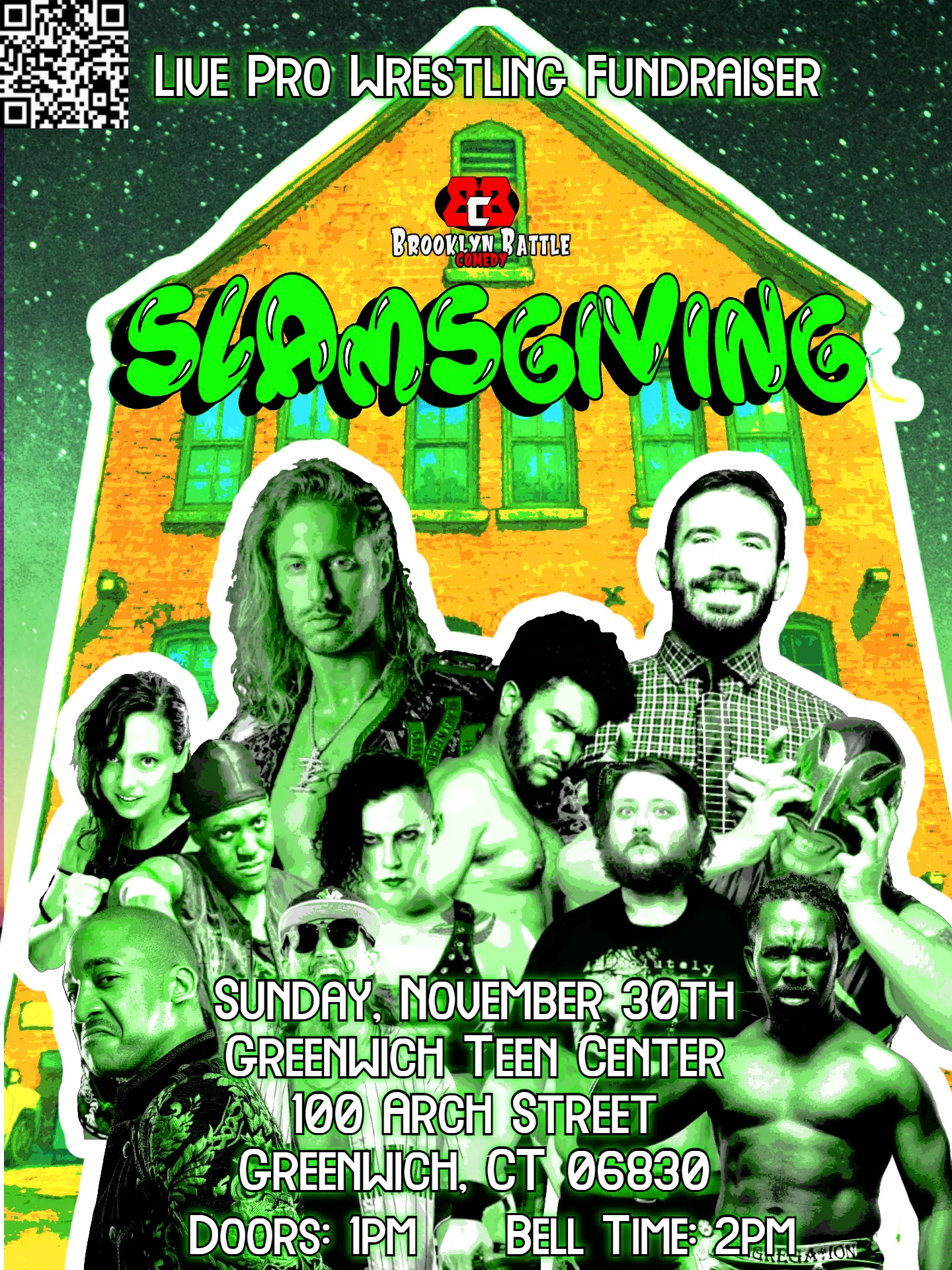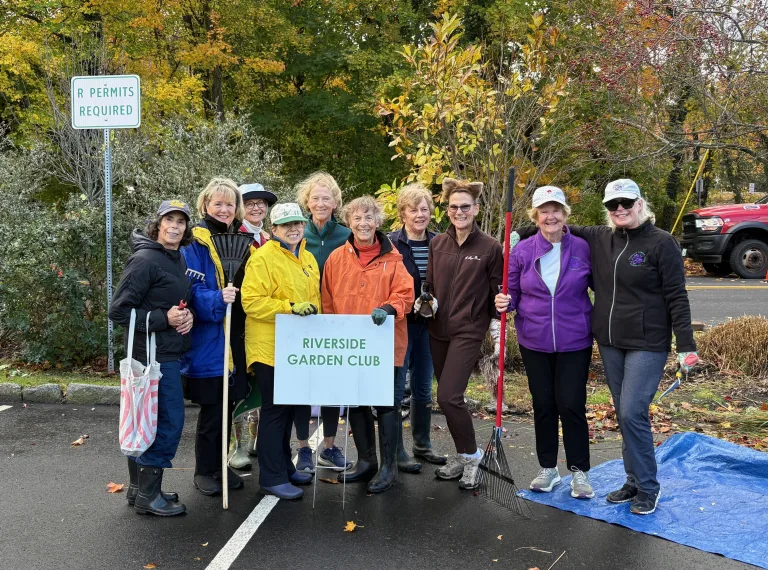By Anne W. Semmes

There’s a new tree species greening Greenwich Avenue as introduced by Tree Warden Dr. Gregory Kramer. “Its common name is the willow oak,” he says, standing by one planted near the CVS Pharmacy. “But it is a true oak,” and “The leaf looks more like a willow leaf than an oak leaf.” And in an urban setting with limited airspace to grow, “It’s a tree that holds its canopy rather tight, so it doesn’t get too broad of a tree.”
Kramer counts some five planted between the Post Road and Lewis Street.
“The other interesting component of willow oak,” he adds, “is it’s a very salt tolerant and urban tolerant tree. So, it tolerates dogs and people compacting the soil. And truth be told, because the leaves are so small, they’re easier to clean up in the fall. And the acorns are very small, and at this latitude they don’t produce a huge number of acorns as much as they produce down south.” And this was where Kramer worked before he arrived as Tree Warden five years ago. “And they also hold their leaves rather late in the season, which is nice – they can hold their leaves until late November, early December.”
And note, Greenwich residents, those willow oaks, that are now interspersed with existing trees, to be extended down to Railroad Avenue, do live long. “The Willow Oak’s average lifespan he tells, “is probably 150 to maybe 200 years, in ideal conditions.”
Kramer is grateful that, “We were able to plant more trees above what exists now.” He points to the important partners in this Replanting Project, especially the Department of Public Works. “They actually created six new tree wells this year south of Fawcett Place.” And add the important partnership with the Greenwich Tree Conservancy (GTC), and in particular its founder, Peter Malkin. “Peter’s a big advocate of planting trees if they are removed,” notes Kramer.
Peter Malkin spells out that advocacy in the backstory and challenges leading to the tree plantings on Greenwich Avenue. “It goes back to when Larry Cooper was the Tree Warden…probably 30 or 40 years ago. Many of the trees on North Maple Avenue, Lake Avenue and Round Hill Road were planted by William Rockefeller when he owned all that property. The trees were beginning to die. They were over a hundred years old.” Seems those trees were planted having been “pulled out of the ground,” rather than from nurseries. “Larry Cooper said you could tell that, because if they had bumps on the lower elements of the trunk, it would show that they were pulled out.”
The Malkins – Peter and Isabel had worked with Tree Warden Cooper on those replantings. “When we saw what had to be done,” says Malkin, “we decided to organize the Greenwich Tree Conservancy [founded in 2007].” The first challenge on the Avenue was, “The streetlights were not working.” Thus came the need “to replace the lights with LED lights,” followed by “replacing the street stanchions with the classical stanchions that we now have…Then that led to the real effort with the trees on Greenwich Avenue as a full-scale thing starting with the arrival of Greg Kramer.”
The first challenge came from the Department of Public Works (DPW) needing to pass on whether a tree would “obscure any turning or other oncoming cars.” Another was needing to know “where were all these submerged pipes and wires,” tells Malkin. And then there was…when a tree was removed, the tree well was blacktopped over… We had to get approval from the DPW to remove the blacktop, remove any stump that was in there, and then find room to plant a new tree.”
There followed Avenue walks with GTC head JoAnn Messina walking with Kramer deciding “on locations where trees could be planted, and then began the process for a couple of years of working with DPW to get approval for doing so.” And in that planting process, “Whatever is not covered by the town budget, GTC will cover,” tells Malkin.
“We’ve also been advocating for the care of existing trees on the Avenue,” adds GTC Executive Director Kate Dzikiewicz, “including arranging for additional soil and mulch to be added to newly expanded tree wells so that the trees already there could continue to grow and thrive.”
But unwanted tree removals became major stumbling blocks. Malkin tells of “that big tree at the northeast corner of Elm and Greenwich Avenue… in front of the new Chase Bank, originally an Italian restaurant … the DPW wanted to take it down to make room for a handicap access ramp.” Malkin’s suggestion to move the ramp five feet away became -after legal confrontations – the tree saving answer.
And most recently there’s the threat of a possibly 50-year-old honey locust tree to be removed at 125 Greenwich Avenue. Malkin surmises that the fronting Shreve, Crump & Lowe was concerned that the tree’s root had “raised the sidewalk an inch or two, causing rainwater to run down the sidewalk into their entrance.” Add to that First Selectman Fred Camillo’s concern that the raised sidewalk “was a terrible tripping hazard. That led to the request that the tree be removed,” says Malkin, “and the tree was posted and that led to a public hearing.”
So, the DPW has done their part to “improve the sidewalk” and at the public hearing Malkin and Kramer presented their defense. “Greg Kramer issued a ruling that he would not allow the tree to be taken down, to give a period of six months to see if there were alternatives that would avoid the need for that.” A contractor “came up with a program that you could have a smooth ramp an inch or two over the root and not have to destroy it.”
Kramer has consulted an arborist “about whether something could be done with the roots of the tree.” He is also to meet up with the DPW, “to show them both the proposed construction improvement to the sidewalk that would eliminate any need to do anything with the root, and also tell them what he had found out from the arborist.”
Malkin is confident he says “that during the six-month period, a few weeks having gone by now, and two solutions have been proposed, a solution will be reached. It’s a major tree, and they hang the town banners from it.”





